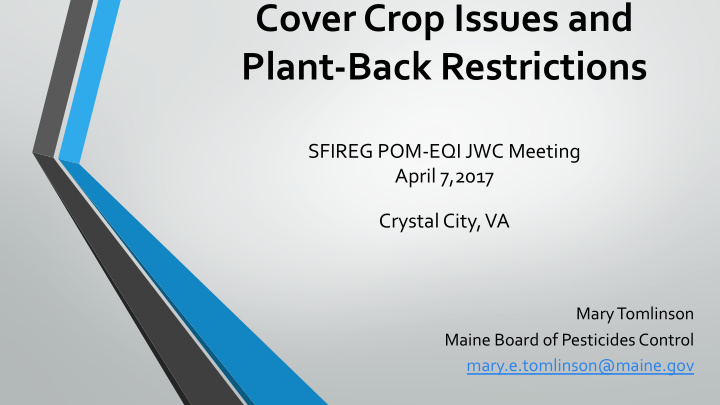



Cover Crop Issues and Plant-Back Restrictions SFIREG POM-EQI JWC Meeting April 7,2017 Crystal City, VA Mary Tomlinson Maine Board of Pesticides Control mary.e.tomlinson@maine.gov
Outline • History of the cover crop and plant-back issue • 2015 herbicide label and NRCS documents review • 2018 EQI WC cover crop and plant-back survey results • Issues identified • Proposed resolutions
History of the Issue • 2015 • Inquiry from private-sector crop advisor • SLITS decision • Reviews by Lebelle Hicks, PhD DABT: herbicide labels and NRCS documents • Consideration by EQI WC • 2016 • Draft issue paper presented to SIFREG EQI-POM JWC • 2018 • EQI WC 2018 cover crop survey
2015 Herbicide Label Review • 32 labels reviewed • 31 of the labels provided some rotational crop information • 12 with specific mention of cover crops - only one species addressed • Some addressed food and/or feed issues and stunting of growth • None addressed the potential uses of cover crops for conservation or food for human consumption.
EQI WC 2018 Cover Crop and Plant-Back Survey Results • 31 states responded to five questions • Respondents: departments of agriculture, extension, NRCS • Wide variety of cropping systems • 25 reported increasing or stable use of cover crops • 17 reported inquiries related to the use of herbicides on primary commodity and rotation restrictions for plants used as cover crops • 4 reported complaints of cover crop damage or residue issues • 3 reported concerns or inquiries related to rotational intervals
Issues Identified • Potential crop damage due to carry-over residues in soil • Potential residues and tolerance exceedances in food, feed, or forage • Poor pesticide label language and disconnect with USDA-NRCS standards and guidances
Proposed Resolutions • Determine whether cover crops can be used for food or feed for humans and other animals • Improve pesticide label language • Standardize language among products and crops • Differentiate between guidelines and restrictions • Update PRN 2000-5 and Label Review Manual to include cover crops • Improve coordination among federal agencies • Support residue studies and bioassays • Organize cropping systems within growing regions to facilitate work on pesticide labels, NRCS 340, and crop rotation issues.
Questions? Mary Tomlinson Maine Board of Pesticides Control 28 State House Station Augusta, ME 04333 mary.e.tomlinson@maine.gov
Recommend
More recommend